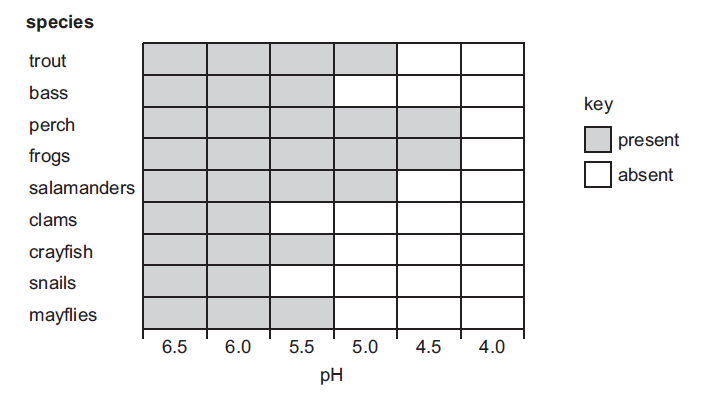Question
What is least likely to result from deforestation?
A increase in flooding
B increase in species
C loss of habitats
D loss of soil
▶️Answer/Explanation
Ans: A – Increase in flooding
Deforestation involves the removal of trees and vegetation from an area, which can have significant environmental impacts. One of the most likely outcomes of deforestation is an increase in flooding. Trees and vegetation play a crucial role in absorbing and retaining rainwater, which helps regulate water flow and prevents excessive runoff. When trees are removed, the land becomes more vulnerable to erosion, and rainwater can flow more rapidly over the surface, leading to increased flooding.
On the other hand, Deforestation often leads to habitat destruction, which can result in a decrease in species diversity rather than an increase and it directly contributes to the loss of habitats for various plant and animal species. Deforestation can also lead to soil erosion and degradation due to the absence of trees that help anchor the soil and prevent erosion. This can result in a loss of fertile topsoil over time.
So, option A (increase in flooding) is the least likely to result from deforestation.
Question
During the treatment of sewage, what is removed by screening?
A. bacteria
B. fats and grease
C. large plastics
D. urine
▶️Answer/Explanation
C. large plastics
During the treatment of sewage, screening is a preliminary step in the process that involves the removal of large, solid objects from the wastewater. The purpose of screening is to prevent these large objects, often referred to as “rags,” from entering the downstream treatment processes, as they can clog pipes, pumps, and other equipment, causing operational issues and potentially damaging the treatment infrastructure. This includes items such as large plastics, sticks, leaves, and other solid materials that could potentially clog or damage downstream equipment and interfere with the treatment process. Screening typically involves the use of bar screens or mesh screens with varying sizes of openings. The wastewater flows through these screens, and objects that are larger than the screen openings are captured and removed. After screening, the wastewater undergoes further treatment processes to remove finer suspended solids, organic matter, nutrients, and pathogens, ultimately producing treated water that can be safely discharged into the environment or reused for various purposes.
Question
The chart shows which species of different animals are present in rivers of different pH.

Which conclusion can be drawn from this information?
A Both frogs and mayflies can live in more acidic river water than trout.
B Clams and snails are most affected by acidic river water.
C Most species can live in river water below pH 5.5.
D Not all species are affected by acidic river water.
▶️Answer/Explanation
B
Clams and snails are most affected by acidic river water.
From the chart, it appears that the presence of clams and snails decreases as the pH of the river water becomes more acidic. These species are almost absent in waters with pH below 6.5. This suggests that clams and snails are highly sensitive to acidic conditions and are most affected by low pH levels in river water. Other species like frogs, perch, and trout seem to have a wider pH tolerance range compared to clams and snails.
Question
To avoid extinction of a rare plant species, a botanical garden keeps a collection of seeds, known
as a seed bank.
Which condition will prevent these seeds germinating whilst in storage?
A high humidity
B high oxygen levels
C low light intensity
D low temperature
▶️Answer/Explanation
D. Low temperature
Low temperature can prevent seeds from germinating while in storage. This is because many plant seeds have evolved to remain dormant during cold periods, which helps them survive harsh environmental conditions. When seeds are exposed to low temperatures, they perceive it as a signal that it’s not yet time to germinate. This adaptation ensures that the seeds won’t start growing during unfavorable conditions, increasing their chances of survival until more suitable conditions arrive.
High humidity, high oxygen levels, and low light intensity do not necessarily prevent germination. High humidity might actually encourage fungal growth and deterioration of the seeds. High oxygen levels are generally important for seed viability, as they are needed for metabolic processes within the seed. Low light intensity could delay germination, but it’s not a strong factor compared to temperature.
Question
What is a reason for conserving plant species?
A to absorb oxygen from the air
B to decrease rainfall
C to obtain drugs for medicinal use
D to release carbon dioxide into the air
▶️Answer/Explanation
C. to obtain drugs for medicinal use
Conserving plant species is important for a variety of reasons, including their potential to provide valuable resources for medicinal purposes. Many plants contain bioactive compounds that can be used to develop medicines and treatments for various illnesses. These compounds can be isolated from different parts of plants such as leaves, roots, stems, and flowers. Conserving plant species ensures that we have a diverse genetic pool to draw from for potential medical breakthroughs. While options A, B, and D are not accurate reasons for conserving plant species (plants are responsible for oxygen production, they do not affect rainfall in that manner, and they absorb carbon dioxide rather than releasing it), option C stands out as a significant reason given the importance of plants in drug discovery and development.
